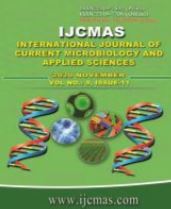


 National Academy of Agricultural Sciences (NAAS)
National Academy of Agricultural Sciences (NAAS)

|
PRINT ISSN : 2319-7692
Online ISSN : 2319-7706 Issues : 12 per year Publisher : Excellent Publishers Email : editorijcmas@gmail.com / submit@ijcmas.com Editor-in-chief: Dr.M.Prakash Index Copernicus ICV 2018: 95.39 NAAS RATING 2020: 5.38 |
Cotton leaf curl disease is the major constraint in cotton production in the Indian subcontinent. A field study (2012-2017) was conducted to assess seed cotton yield on Bt cotton cultivars analogous to the symptom rating scales (DRS) of CLCuD. The DRS is used to derive the percent disease intensity (PDI). Presently, percent disease index (PDI) for resistance screening ranges between 0.1 to 50%, corresponding to the DRS 1 to 6, which is lower than the mathematical midpoint value ranging between 8.4 to 91.8% and breeding material with good yield potential may be ignored during screening. The average yield loss corresponding to the DRS 1, 2, 3, 4, 5, and 6 was 15, 28, 38.6, 49.1, 59.1 and 72.1%. Hence, the newly proposed disease response scale would be much more justifiable and reliable for decision-making and determining the level of resistance or susceptibility in the genotypes, because the estimated severity may be much lower than the actual severity.
 |
 |
 |
 |
 |